Greetings!
I’m settled back into Britain now and my memories of the DPRK are fading as fast as the pain in my leg which I injured doing a bit of traditional Korean wrestling in Chilbo-san. But something stays with me and so I’m reading Andrei Lankov’s ‘The Real North Korea’, one of the better books on the DPRK and streets ahead of John Sweeney’s abysmal ‘North Korea Uncovered’, a book so sensationalist and ill-researched that he should be sent to the country that he dislikes so much for a decade as penance for his crime against travel writing. Don’t worry, I’ll review it one day.
In the meantime though, I’ll keep reading Lankov which, at least, takes one’s mind off the absolute political misery of the UK following last week’s election. Even thinking about the future hurts too much at present and at 3 o’ clock last Friday morning. I must admit that even the DPRK appeared, for a fleeting moment, as a tempting alternative.
Keep travelling!
Uncle Travelling Matt
Links to all parts of this travelogue
Day 5: Sisian to Stepanakert and Gandazar
Postscript: A Georgian Minibreak
And also check out my 2010 trip to the lost lands of the Armenians in Eastern Turkey!
Day 1 – Tbilisi to Yerevan
Due to the insomnia of the night before, I must confess to seeing little of the journey from Tbilisi to the border. We started off amongst scruffy post-Soviet sprawl and I awoke in a narrow river valley of incredible brownness. The rocks were brown and the sparse, hardy vegetation brown too. And at the border the people were of a noticeably darker hue than their Georgian neighbours. That I did notice and what also caught my eye was that the girls were much prettier. No offence is meant to Georgia here; I find her people to be amongst the most welcoming on earth but the girls, on the whole, do not set my pulse racing particularly fast. Judging from the border though, the same could not be said of Armenia. This was the land where Kim Kardashian's ancestors – and for that matter, young Araksia's – hailed from and it showed with a bevy of dusky, curvaceous beauties waiting in line to have their passports stamped. I smiled; something told me that I was going to like this place.
The Debed Valley through which we rattled after the border was narrow, almost a gorge. We were hemmed in on either side by brown hills, whilst below us the brown waters flowed. The valley floor however, was strewn with detritus from the Soviet era, the skeletal hulks of exhausted factories, mines and other industrial concerns, the decaying remains of a grand vision of how the world should be that never quite worked out. I was reminded of Albania, and particularly of the journey up a similar, albeit wider and slightly greener, valley from Gjirokastro to Tirana. This parallel was further enhanced when we stopped at a small roadside eatery. On my Albanian journey we'd halted at a similar establishment though here, at what was once the opposite end of the same empire as Albania, I didn't dine and instead Paul and I headed down to the riverside to gaze at the churning brown flow and drink invigorating water from a spring topped by a beautifully-carved stone. As the journey progressed it became apparent that Armenians value both springs and carved stones very much and there are thousands of the former decorated with the latter across the land, a hangover perhaps from those distant times before the advent of Christianity when the Armenian religion was based around worshipping water spirits.
Whilst waiting at that pleasant spot, whilst not eating, I did purchase a bottle of ayran which in those parts, as in Uzbekistan, generally comes carbonated. I fell in love with ayran, the salted yoghurt drink popular from Bosnia to Iran, the moment that I first tasted in on my first trip to Bulgaria back in 1998, but Paul had never heard of it before, so I let him have a swig of mine to see what he thought. Sadly, I must report that his thoughts did not marry my own and he categorically stated that no more would ever pass his lips in the future.
The first settlement of any consequence that we passed through was the town of Alaverdi, unusual in Armenia since it has an Islamic name (“Allah gave” in Turkish). It looked an interesting place and well worth a stop, something which we considered but, alas, ran out of time for. It was a copper mining settlement and everything was built out of the same reddish-brown volcanic stone as the hills, perhaps because it is hard-wearing or perhaps because the area has very few trees.[1] There was also a rather cool-looking cablecar heading up the side of the valley to where there stands a noteworthy monastery. Oh well, perhaps next time...
The Debed Valley continued both brown and narrow until just before the city of Vandazar which may be Armenia's second-biggest since the other contender for that honour, Gyumri, (formerly Leninakan, Araksia's home city), had been heavily depopulated following the 1988 earthquake. Unfortunately, our marshrutka did not head into the city itself, instead skirting it to the north, although I must say that it looked an incredibly downtrodden place indeed.
After Vandazar the landscape changed completely. Browns were replaced by greens, but not the vibrant greens of the Alps or Mediterranean, instead the more staid greens of the Scottish Highlands or wilds of Tibet. The land now was vast, windswept and empty, and snow still lay on the ground in many places whilst trees were nowhere to be seen. It could almost have been Snowdonia, almost but not quite for whilst there were many similarities, there was also something undoubtedly yet indescribably Asian about the whole scene.
We turned south off the main Vandazar to Gyumri road at Spitak which was the epicentre of the 1988 earthquake. Unsurprisingly, the town looked pretty new and in addition to the large memorial to those who died on the top of a low hill, we also saw rows of temporary houses built to shelter those who had lost everything I the tremor. Again, we both would have liked to have stopped and again we would have done so if we had had time to do so and so, again, maybe next trip...?
Once out of Spitak we climbed the magnificent Pambak Pass out of the valley and onto the high plateau still half-covered in snow. We rattled along the pretty appalling road passing villages which looked as if they had been transplanted from the Himalayas. Many had low houses with turf roofs, something that I recalled seeing on the steppe near to Kars in Turkey back in 2010, but then that should not have come as such of a surprise: altitude the two are similar and, as the crow flies, only a hundred miles or so separates them.
An hour or more later we dropped down from the high plateau and into the grassy, messy morass around Yerevan, an unattractive mix of Soviet dereliction, capitalist sprawl and the tasteless nouveau riche mansions of the local mafia dons and politicians. By this time though, I was desperate for the toilet and my only emotion as we rolled into Kilikia Bus Station was one of profound relief.
We dined in the bus station's canteen – cheap and with a wide range of food that you can point at – and then took advantage of its facilities to leave Paul and the bags at a table whilst I changed some money in a bureau across the road. Whilst there I spied a hotel so went across to check out the rooms and prices. Both seemed reasonable, (there were two options, standard at 7,000 dram per room per night and basement at 5,000 dram), and so I retrieved Paul and we checked both options out before agreeing to take a basement room for the next three nights. True, it was a bit of a dingy dungeon, but in a capital city it represented a very cheap sleep indeed and being next to the bus station and hordes of taxis meant that it would be ideal for getting about. In the event, it transpired that we could not have made a better choice.
Accommodation settled with minimum fuss and cash in hand, we took a bus into the city centre. Another advantage of the hotel was that it was on a major bus route and every minute or so one passed bound for the centre. We alighted at France Square by the opera house but even before we'd got off the bus we both knew that this was going to be a good city to hang out in for a few days. Driving down Mesrop Mashtots Avenue we'd seen handsome buildings with some fine architecture. Gone was the concrete sprawl and decay of the standard post-Soviet city and in its place rows of elegant buildings all constructed out of the same hard-wearing, reddish-brown volcanic stone which we'd seen so much of in Alaverdi. In Asia, here was a city that was very European and yet, not quite. The general style and layout were undoubtedly Central European yet no city on my continent uses such stone and the style of the buildings also had an undeniable Oriental element to them. And on the right there was the entrance to a very Persian-looking mosque whilst to the left a glorious-looking covered market that looked well worth checking out later.
But it was not the buildings that took our breath away, instead it was the locals. Standing and sitting on our bus, striding down the streets and now milling around France Square were, quite frankly, the most beautiful selection of females that I have ever had the good fortune to clasp my eyes upon. Now, politically correct or not as it may be to talk about such things, but I have to admit that a great weakness of mine is gazing upon beautiful women. That is, I must add strongly, as far as it goes; my religious sensibilities would cause me to suffer from great pangs of guilt were I to go any further without intending a serious relationship, but alas, Christ's exhortation to gouge out your offending right eye[2] is perhaps the teaching of His that I have always struggled with the most. And nowhere was that the case more than in Yerevan. Imagine for a moment if you please, Kim Kardashian (yes, nice thought, I know) then multiply that imagine a thousandfold and there you have the streets of the Armenian capital. Dusky-skinned, doe-eyed beauties with an absolute elegance and femininity of movement which meant that even the lesser beauties can make a man weak at the knees by the way they move, whilst their figures, elegantly clad in tight jeans or tight tops and... ok, so you get the picture. Actually you don’t, trust me, unless you've been to Yerevan, you don't. But hey, if you don't trust me, then ask Osip Mandelstam, literary giant of the USSR, who described the ladies of Armenia as “women of leonine beauty”[3] or let me tell you about Paul, yes indeed, I shall talk of Paul.
Now Paul is a man whom I have known for a good seven years and whilst undoubtedly straight, his soul is perhaps not as superficial as mine, or at least, he is not as visually stimulated shall we say. The Lord's commandment regarding right eyes, I suspect, he has less trouble keeping and indeed, I even did a test on the matter once. We were walking in Wales and went into a pub for a pint and a meal and were served by a rather charming young waitress. Later that evening, as we were discussing looking at the ladies, I asked him to recall who had served us that afternoon. Beyond the fact that it had been a woman, he could remember nothing about her. I, on the other hand, am rather ashamed to admit recalling a great deal about her, even to this day. What I am trying to say is that I had never once noticed Paul engaged in the activity commonly referred to as ogling. Or at least, I hadn't until we hit Yerevan. There he did very little else and when not doing it, was forever commenting on what he had seen. I was glad, it was like a welcome to my world Paul and, of course, it helped assuage my guilt a little.
The Cascade is one of the main attractions of Yerevan. Its construction began in 1971 and it was intended to be an enormous artificial waterfall that would commemorate fifty years of Soviet rule, but when the Soviet Union collapsed in 1991 the rule that it had dished out disintegrated and thus the Cascade, like so much in the former USSR, began to crumble and decay. Renovations started in 2002 and in 2009 it was reopened as the Cafesjian Centre for the Arts, one of the most exciting and innovative arts spaces in the world.
It was named after – and paid for by – Gerard Cafesjian, an Armenian American who was born in the USA to parents who had survived the 1915 genocide. He made his fortune in publishing and upon retirement became a great philanthropist and promoter of the Armenian identity globally, (in addition to the Cascade, he has opened a genocide museum in his home city of New York). Armenia has a massive expatriate community which contributes millions to the local economy every year and which have helped it to become something of an economic miracle, a country which is prospering despite its two longest borders (with Turkey and Azerbaijan) being closed, its neighbour Georgian to the north still reeling from the 2008 conflict with Russia and its neighbour to the south, Iran, being an international pariah state, in addition to its own domestic lack of natural resources and good farming land.
 The Tamanian Statue with the Cascade behind
The Tamanian Statue with the Cascade behind
Now I must admit here that, despite having a brother who is an acclaimed painter in oils, I struggle to “get” a lot of art, particular much of the more modern and abstract stuff. Nonetheless, I rather enjoyed our stroll up the Cascade as there was plenty to look at, (and I'm not just talking about the female art appreciators there). At the foot, along Tamanian Square, alongside the magnificent Soviet era statue of Hovannes Tamanian – more on him later – carved from a single block of basalt, were a series of statues including some chunky cartoonish characters by the Colombian artist Fernando Botero which I rather liked, although the ones by British sculptress Lynn Chadwick which my guidebook raved about, without wishing to sound unpatriotic, I considered crap.
The Cascade itself is like a gigantic staircase with sculptures on the various steps. You get up it by going inside the left-hand side where there is an escalator with various pieces of (largely uninspiring) modern art to look up as you rise upwards. At the top was an exhibition of sculptures using diamonds which was very Kardashian I thought, but generally speaking, it was the space itself rather than the art inside it which was memorable.
The exception to that though was situated in a subterranean gallery halfway up. This was a huge triptych of paintings by Grigor Khaniyan commissioned specially for the space and telling the story of the Armenian nation. The first celebrated the introduction of the Armenian alphabet which might seem a strange choice of subject for the central piece of a work telling the story of a nation, but it is appropriate since most historians agree that without their distinctive alphabet – as with their unique church – the Armenians would have suffered the same fate as all the other nations on a Biblical map and been subsumed and then lost in the identities of one or more of the great empires who continually lapped at Armenia's borders. Indeed, a look at the other great survivor from that era, the Jews, who also had their own faith and alphabet makes you realise that such things might well be more important that possessing land. In his book 'The Crossing Place' which explores the Armenian nation and identity around all the Near and Middle East, Philip Marsden asks Father Levon Zekiyan, Venice's Armenian priest the question of what keeps the Armenians Armenian, to which the priest replies,
“'The whole thing comes down to a single idea. And the key to it is the script. Mesrop Mashtots was our greatest political thinker! In the fifth century he invented the alphabet – he realized Armenia as a power was finished. If the Armenians were to survive without territory, they had to have a common idea, something that was theirs alone. The script embodies the idea.'
'And what was the idea?'
'Ah, you cannot describe it. If you are lucky, you will come to know it a little.' He took a sip of his wine and smiled. 'Our poet Sevak called it simply Ararat.'”[4]
 The Introduction of the Armenian Alphabet
The Introduction of the Armenian Alphabet
The second painting depicted the Battle of Avarayr which was fought against the Persians in 451. Although technically a defeat, the Armenians, like the Serbs with Kosovo Field, see it as the turning point in their national history. In danger of being extinguished and partitioned between the Roman and Persian empires, their stubborn resistance resulted in taxes on them being removed and freedom of religion granted, thus guaranteeing their survival as a unique nation, (since their church differed from everyone else's).
The final panel, Rebirth, tells the story of the resurgence of the Armenian identity from the dust and ashes of those empires that dominated it and, rather romantically, only hours after putting the final touches to the face of the final figure, Mother Armenia, Khaniyan died.
As anyone who has read much of my work will know only too well, I am no nationalist. Indeed, I sincerely believe that ideology to be the cause of more misery and death on this earth than any other. That said, it – like its more extreme Stalinist and fascist forms – has some wonderful iconography and I could have stared at those paintings for hours. They were busy, a mass of people, symbols and colours, and I would have loved to have been able to depict it all. Khaniyan was born in 1924 and so was educated and grew up under Stalinism with its aggressive Soviet nationalism and his art shows signs of the socialist realism of the period. But he yearned for more freedom to express a distinctive Armenian identity and because of his privileged position as a favourite artist of the regime, he was able to travel and it was whilst doing that in the most unlikely of places, that he found his inspiration.
Albania, and particularly Enver Hoxha's extreme Stalinist Albania, is rarely cited as an influence on today's contemporary artists, but it lit a fire in Khaniyan. Hoxha was a strict Stalinist, but he had also broken away from the rest of the socialist world and in order to help justify his political isolationism he promoted a policy of self-determination and with it a cult of Albanianism, (not dissimilar in both style and content to the Juche ideology of the current North Korean regime), which stressed the unity of the Albanian people despite their difference in religion, and of their continuity over the centuries, painting his dictatorship as the natural culmination of the efforts of a people descended from the Ancient Ilyrians. Thus, in the world of art, whatever was Albanian was in and Khaniyan was electrified by what he saw as “the vital connection with the genius of traditional handicrafts.” The attraction to an ardent but suppressed Armenian nationalist is clear and I must admit that if there is one work in the world which reminds me of Khaniyan's magnum opus, it is the huge mosaic which graces the entrance to the National Museum in Tirana and is entitled simple 'Albania!'.
At the top of the Cascade we stood and admired the views, (both the stunning panorama across the city and the more feminine charms in the foreground), and wondered if the unfinished section between the top of the Cascade and the Soviet monument on the crest of the hill would ever be finished, (Cafesjan's foundation is planning a museum but work has reportedly ground to a halt), and then we descended back down to ground level to enjoy a very civilised coffee amongst the chunky cartoon statues on Tamanian Street.
Hovannes Tamanian is a figure who cannot be ignored by any visitor to Yerevan. More than any other Soviet city that I have visited, Armenia's capital comes across as a single, planned whole which is perhaps a little surprising since it was established as long ago as 782BC and has been inhabited continuously ever since, making it older than Rome. However, Yerevan was never the capital of Armenia, more a small provincial town and as late as the 19th century when the Russians took over, Gyumri was the main city. Everything changed though on the 28th May, 1918 when it was declared that the capital of the First Armenian Republic would be Yerevan, (presumably because of its less exposed position with relation to the Turkish border), and between 1924 and 1926 Hovannes Tamanian was commissioned to create a masterplan for the city which would make it worthy of its new status as the capital of the Armenian SSR.
The result is spectacular and, as we walked around the city over the days that followed, we could only admire Tamanian's vision. His Yerevan was circular, part of the circle being defined by the Hrazdan River but the majority by a green belt, a long thin park, now sadly being eroded away by a number of post-Soviet buildings. But it is within the ring that Tamanian's legacy is finest, broad avenues faced with handsome buildings constructed of tuff, the beautiful reddish-brown volcanic stone; European yet also Asian in their design and ornamentation. There is no city on earth similar to Yerevan, a boast that is unique amongst Soviet cities which tended to be very identikit, and that is largely due to Tamanian's sweeping vision, although it must be added, that some priceless architectural treasures were destroyed to make room for his masterpiece.
We walked through Tamanian's Green Belt and then down Abovian Street towards Republic Square, the heart of the city, passing the statue of Kara Bala on the way. He was something of a local celebrity, the kind of guy who gives a city character. A well-off gent who grew roses in his garden, he would go to Abovian Street and hand them out to pretty girls passing by, in particular one famous actress, Arus Voskanian, whom he presented with a rose every morning as she walked to the theatre. However, he was not alone in vying for her affections, a Turkish man also loved her and so jealous did this make Kara Bala that he murdered his rival. He was subsequently imprisoned for his crime and when he was eventually released years later, his wife had left him, his house sold and all his beloved roses uprooted. Distraught, he declared that he was no longer Kara Bala but instead Dardy (literally, “sorrow”) Bala. Even so, he still wandered the streets of Yerevan, now with a bottle for company, giving out flowers to pretty girls walking by. Eventually he died, found frozen one morning sitting on a rock and the whole city mourned him. Personally, I'm not sure what to make of the tale. I understand that beautiful women can drive a man mad and that Yerevan's muses are perhaps the most captivating on earth, but even so, murder is murder, and what no one seems to consider is how his devoted wife felt about it all? Nonetheless, one has to admit that the little statue of an old man handing out a rose comes as a welcome change from the usual generals and politicians.
I loved Republic Square. Conceived as Lenin Square, (and originally boasting a statue of the little great man), it is the cherry on Tamanian's iced cake and one of the finest public squares on the planet. It reminded me a little of Milan's Piazza del Duomo although I'm unsure why since save for the fact that they are similar in size, the two have little in common. However, it may be a comparison that Tamanian – and to be more precise, his communist commissioners – would appreciate for whilst Republic Square, like the Piazza, is fronted on three sides by fine neo-classical buildings, the centrepiece here is not a Gothic cathedral but instead a temple of socialism, the Museum of the Bolshevik Revolution, (nowadays the State History Museum), a homage to human, not divine achievements. Taken as a whole though, whilst no single building can match the glory of Milan's Duomo, Tamanian's ensemble, all executed in warm-hued tuff, is by far the superior space.
We finished off our first day in Armenia by dining at an excellent traditional restaurant housed in a cellar nearby where we gorged ourselves on fine salads, pork ribs, aubergine and several pints of beer, before returning to Republic Square to watch the illuminated fountains dance to famous pieces of classical music, a scene more Central European than Central Asian, before then retiring to a nearby coffee shop to do justice to old Kara Bala's memory by drinking more beer whilst watching the girls go by, while in the background Borussia Dortmund played Real Madrid.
Next part: Echmiadzin and Yerevan
[1] This lack of trees may be natural or it may be due to the acute fuel shortages during the 1990s which caused the locals to cut down a lot of trees for firewood.
[2] Matthew 5:29; Mark 9:47
[3] Quoted in 'The Crossing Place', p.156
[4] The Crossing Place, p.17

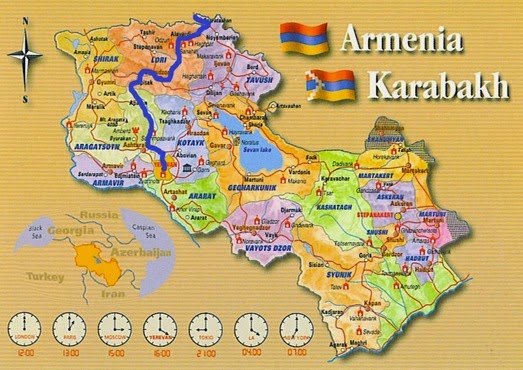
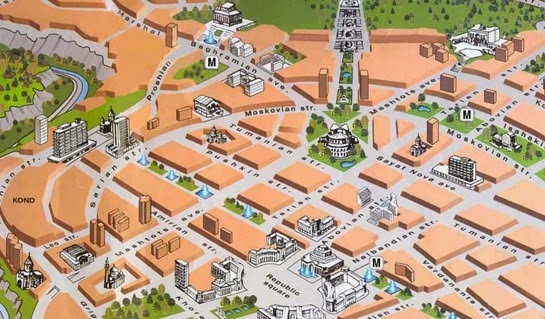

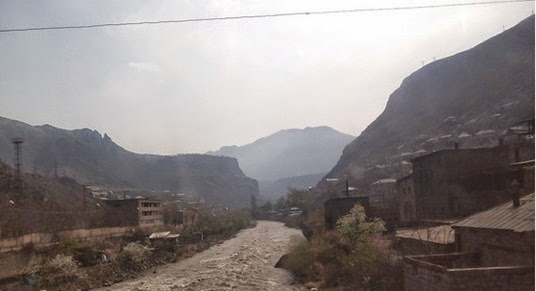
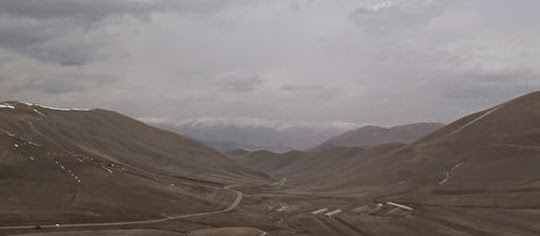
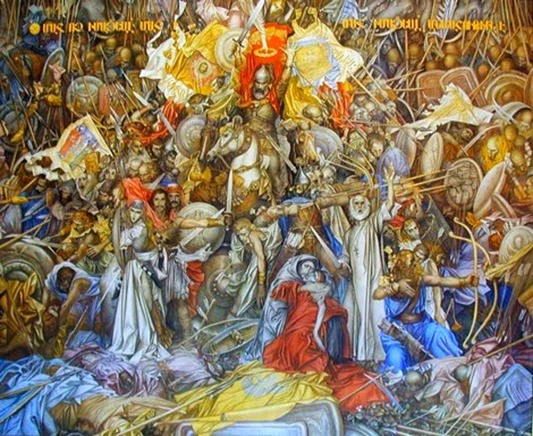
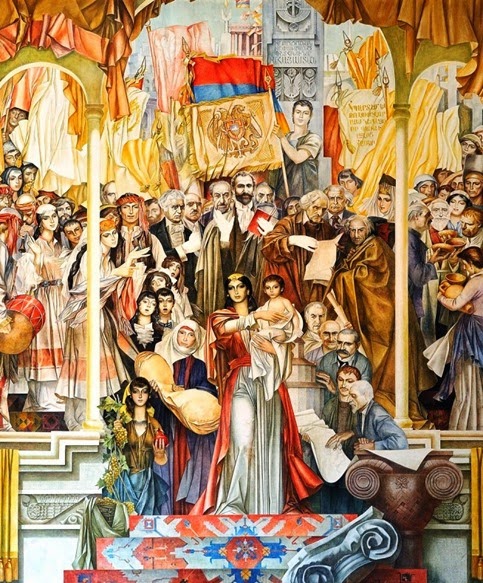


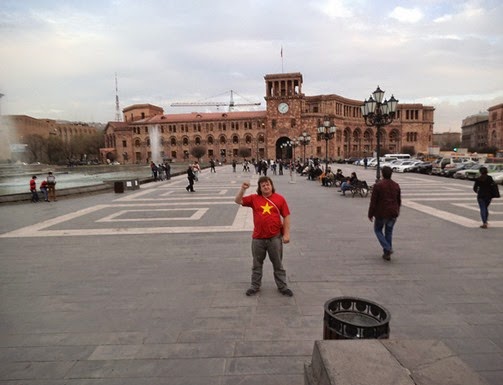
No comments:
Post a Comment